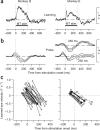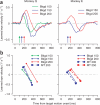Instructive signals for motor learning from visual cortical area MT
- PMID: 15908949
- PMCID: PMC2430765
- DOI: 10.1038/nn1470
Instructive signals for motor learning from visual cortical area MT
Erratum in
- Nat Neurosci. 2005 Jul;8(7):969
Abstract
Sensory error signals have long been proposed to act as instructive signals to guide motor learning. Here we have exploited the temporal specificity of learning in smooth pursuit eye movements and the well-defined anatomical structure of the neural circuit for pursuit to identify a part of sensory cortex that provides instructive signals for motor learning in monkeys. We show that electrical microstimulation in the motion-sensitive middle temporal area (MT) of extrastriate visual cortex instructs learning in smooth eye movements in a way that closely mimics the learning instructed by real visual motion. We conclude that MT provides instructive signals for motor learning in smooth pursuit eye movements under natural conditions, suggesting a similar role for sensory cortices in many kinds of learned behaviors.
Figures






Similar articles
-
Doing without learning: stimulation of the frontal eye fields and floccular complex does not instruct motor learning in smooth pursuit eye movements.J Neurophysiol. 2008 Sep;100(3):1320-31. doi: 10.1152/jn.90492.2008. Epub 2008 Jun 25. J Neurophysiol. 2008. PMID: 18579657 Free PMC article.
-
Primate area MST-l is involved in the generation of goal-directed eye and hand movements.J Neurophysiol. 2007 Jan;97(1):761-71. doi: 10.1152/jn.00278.2006. Epub 2006 Oct 25. J Neurophysiol. 2007. PMID: 17065255
-
Visual-tracking neurons in area MST are activated during anticipatory pursuit eye movements.Neuroreport. 2003 Dec 2;14(17):2219-23. doi: 10.1097/00001756-200312020-00017. Neuroreport. 2003. PMID: 14625451
-
The neuronal basis of on-line visual control in smooth pursuit eye movements.Vision Res. 2015 May;110(Pt B):257-64. doi: 10.1016/j.visres.2014.06.008. Epub 2014 Jul 1. Vision Res. 2015. PMID: 24995378 Free PMC article. Review.
-
Visual pursuit: an instructive area of cortex.Curr Biol. 2005 Aug 23;15(16):R638-40. doi: 10.1016/j.cub.2005.08.004. Curr Biol. 2005. PMID: 16111938 Review.
Cited by
-
Sensory population decoding for visually guided movements.Neuron. 2013 Jul 10;79(1):167-79. doi: 10.1016/j.neuron.2013.05.026. Neuron. 2013. PMID: 23849202 Free PMC article.
-
Insights into cortical mechanisms of behavior from microstimulation experiments.Prog Neurobiol. 2013 Apr;103:115-30. doi: 10.1016/j.pneurobio.2012.01.006. Epub 2012 Jan 28. Prog Neurobiol. 2013. PMID: 22307059 Free PMC article. Review.
-
Doing without learning: stimulation of the frontal eye fields and floccular complex does not instruct motor learning in smooth pursuit eye movements.J Neurophysiol. 2008 Sep;100(3):1320-31. doi: 10.1152/jn.90492.2008. Epub 2008 Jun 25. J Neurophysiol. 2008. PMID: 18579657 Free PMC article.
-
Playing the electric light orchestra--how electrical stimulation of visual cortex elucidates the neural basis of perception.Philos Trans R Soc Lond B Biol Sci. 2015 Sep 19;370(1677):20140206. doi: 10.1098/rstb.2014.0206. Philos Trans R Soc Lond B Biol Sci. 2015. PMID: 26240421 Free PMC article. Review.
-
Saccades exert spatial control of motion processing for smooth pursuit eye movements.J Neurosci. 2006 Jul 19;26(29):7607-18. doi: 10.1523/JNEUROSCI.1719-06.2006. J Neurosci. 2006. PMID: 16855088 Free PMC article.
References
-
- Schultz W, Dickinson A. Neuronal coding of prediction errors. Annu. Rev. Neurosci. 2000;23:473–500. - PubMed
-
- Rescorla RA, Wagner AR. A theory of pavlovian conditioning: variations in the effectiveness of reinforcement and nonreinforcement. In: Black AH, Prokasy WF, editors. Classical Conditioning II: Current Research and Theory. Appleton Century Crofts; New York: 1972. pp. 64–99.
-
- Ito M. Neural design of the cerebellar motor control system. Brain Res. 1972;40:81–84. - PubMed
Publication types
MeSH terms
Grants and funding
LinkOut - more resources
Full Text Sources
Other Literature Sources

